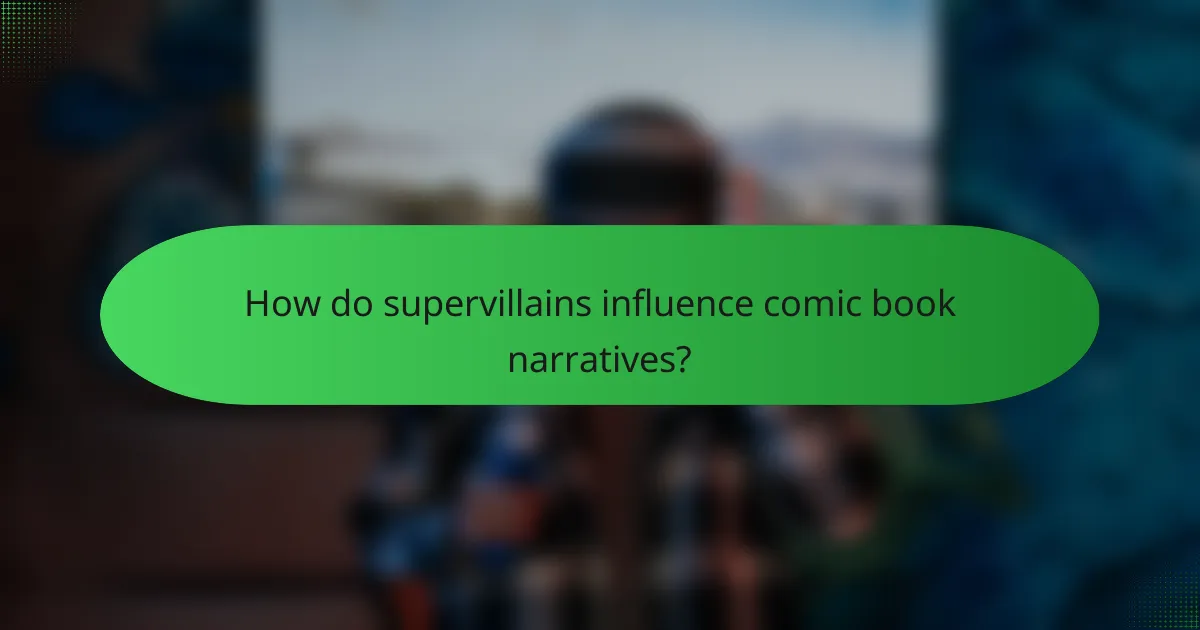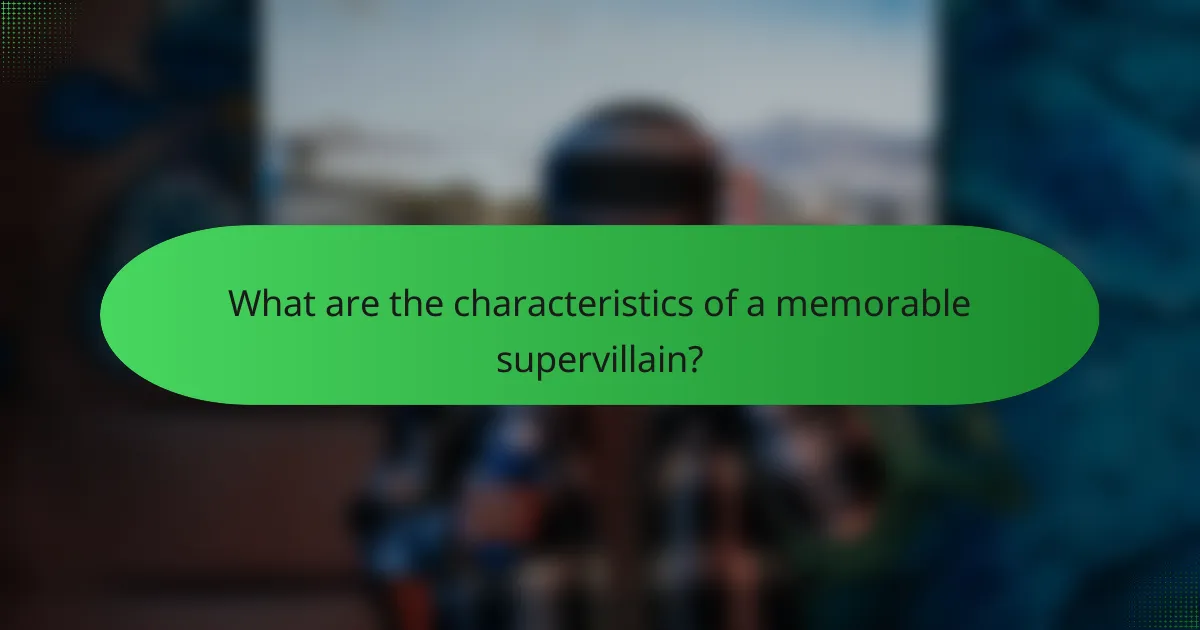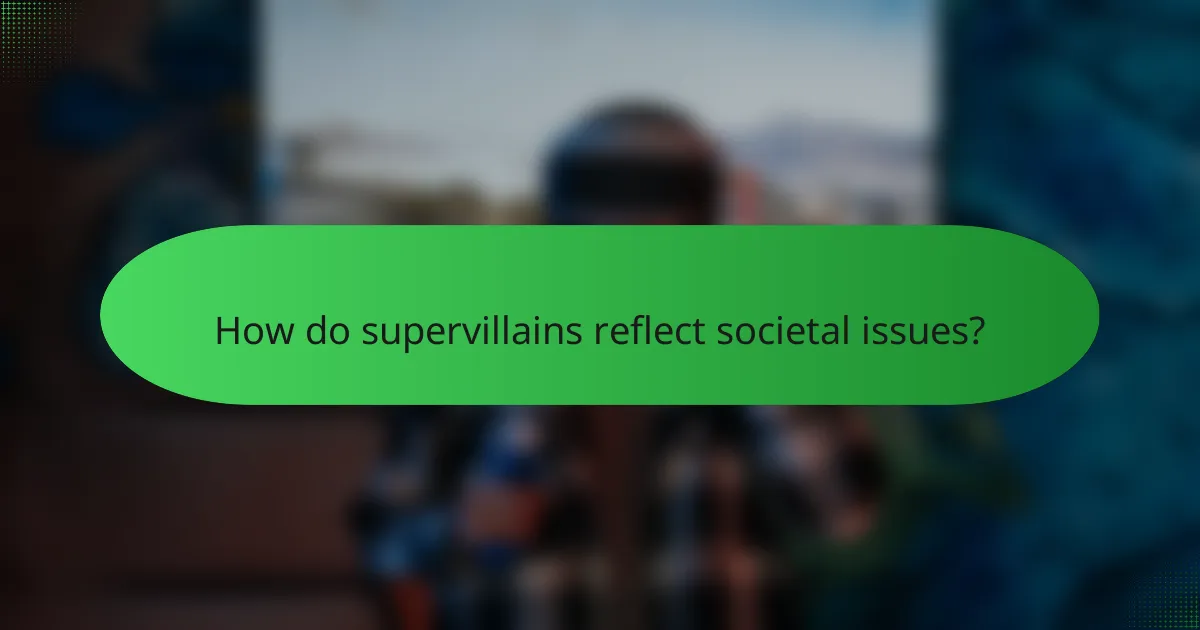Supervillains have become integral to pop culture, influencing movies, comics, and television series with their complex motivations and memorable portrayals. Characters such as the Joker, Thanos, and Lex Luthor not only provide conflict but also challenge heroes, driving narratives that explore moral dilemmas and character growth. Their impact extends beyond the screen and page, permeating merchandise and shaping audience perceptions of good and evil.
![]()
What are the most iconic supervillains in movies?
Some of the most iconic supervillains in movies have become cultural touchstones, often embodying complex themes and moral dilemmas. Characters like the Joker, Thanos, and Magneto have left lasting impressions due to their unique motivations and memorable portrayals.
Joker from The Dark Knight
The Joker, as portrayed by Heath Ledger in “The Dark Knight,” is a quintessential supervillain known for his chaotic nature and philosophical outlook on society. His unpredictable behavior and dark humor challenge the moral fabric of Gotham City, making him a formidable opponent for Batman.
Ledger’s performance earned critical acclaim, showcasing the Joker’s ability to manipulate and instigate fear. This character’s legacy continues to influence portrayals of villains in cinema, emphasizing the importance of depth and complexity in villainous roles.
Thanos from Avengers: Infinity War
Thanos, featured in “Avengers: Infinity War,” is a supervillain driven by a twisted sense of balance and destiny. His quest to eliminate half of all life in the universe stems from a belief that overpopulation leads to suffering, making him a unique antagonist who believes his actions are justified.
The character’s portrayal highlights the moral ambiguity often found in supervillains, as audiences grapple with his motivations. Thanos’ use of the Infinity Stones also showcases the power dynamics at play in the Marvel Cinematic Universe, making him a memorable figure in pop culture.
Magneto from X-Men
Magneto, a central figure in the “X-Men” series, represents the struggle for mutant rights and the consequences of prejudice. His backstory as a Holocaust survivor informs his fierce protection of mutantkind, often placing him at odds with the X-Men, who advocate for peaceful coexistence.
This complexity makes Magneto a compelling supervillain, as he embodies themes of survival and vengeance. His character challenges viewers to consider the fine line between heroism and villainy, making him a significant figure in superhero narratives.
Voldemort from Harry Potter
Voldemort, the primary antagonist in the “Harry Potter” series, is a supervillain driven by a desire for immortality and pure-blood supremacy. His fear of death and obsession with power lead him to commit heinous acts, positioning him as a classic dark wizard.
Voldemort’s character serves as a cautionary tale about the dangers of unchecked ambition and hatred. His presence throughout the series emphasizes the importance of love and friendship in overcoming evil, making him a pivotal figure in the franchise.
Green Goblin from Spider-Man
The Green Goblin, as portrayed in Sam Raimi’s “Spider-Man,” is a supervillain characterized by his dual identity as Norman Osborn. His transformation into the Green Goblin highlights the themes of madness and the impact of technology on humanity.
This character’s personal connection to Spider-Man adds emotional depth to their conflict, making their battles more than just physical confrontations. The Green Goblin’s iconic glider and pumpkin bombs have solidified his status as one of Spider-Man’s most memorable foes in pop culture.

How do supervillains influence comic book narratives?
Supervillains play a crucial role in shaping comic book narratives by providing the primary source of conflict and tension. Their actions and motivations drive the plot, challenge heroes, and create opportunities for character growth and moral exploration.
Driving conflict and plot development
Supervillains are essential for creating conflict in comic book stories. They often present formidable challenges that heroes must overcome, which propels the narrative forward. For instance, a villain’s plan to take over a city can lead to a series of confrontations that build suspense and engage readers.
Moreover, the complexity of a supervillain’s schemes can introduce twists and turns in the plot, keeping the audience invested. The stakes often escalate as heroes face not only physical battles but also psychological and emotional dilemmas posed by their adversaries.
Character development for heroes
Supervillains significantly contribute to the development of heroes’ characters. By confronting villains, heroes are forced to confront their own values, strengths, and weaknesses. This dynamic often leads to growth, as heroes learn from their encounters and evolve in response to the challenges presented by their foes.
For example, a hero may start off naive and idealistic but, after facing a cunning villain, may become more strategic and resilient. This evolution not only enhances the hero’s depth but also makes their victories more satisfying for the audience.
Exploring moral ambiguity
Supervillains often embody moral ambiguity, prompting readers to question the nature of good and evil. Their complex motivations can blur the lines between heroism and villainy, leading to rich storytelling opportunities. For instance, a villain may commit crimes for a cause that resonates with the audience, challenging the hero’s perspective.
This exploration of moral ambiguity encourages readers to engage with the narrative on a deeper level, as they grapple with ethical dilemmas and the consequences of choices made by both heroes and villains. Such themes are prevalent in many modern comic book stories, reflecting societal issues and personal struggles.

What are the most popular supervillains in television series?
The most popular supervillains in television series often embody complex characters that challenge heroes and captivate audiences. Iconic figures like Lex Luthor, Wilson Fisk, and Harley Quinn have become staples in pop culture, each bringing unique traits and narratives that enhance their respective stories.
Lex Luthor in Smallville
In the series “Smallville,” Lex Luthor is portrayed as a multifaceted antagonist who evolves from a troubled youth into a formidable foe for Superman. His intelligence, ambition, and moral ambiguity make him a compelling character, often blurring the lines between heroism and villainy.
Lex’s relationship with Clark Kent is central to the narrative, highlighting themes of friendship, betrayal, and the quest for power. His character arc demonstrates how personal experiences and choices can lead to a dark path, making him relatable yet menacing.
Wilson Fisk in Daredevil
Wilson Fisk, also known as Kingpin, is a central villain in “Daredevil,” characterized by his immense physical presence and strategic mind. He operates in the shadows, manipulating events to maintain control over Hell’s Kitchen while presenting a façade of philanthropy.
Fisk’s complexity is revealed through his backstory, showcasing his motivations rooted in love and loss. This depth adds layers to his character, making him not just a villain but a tragic figure whose actions stem from a desire to protect his vision of the city.
Harley Quinn in Batman: The Animated Series
Harley Quinn, introduced in “Batman: The Animated Series,” quickly became a fan favorite due to her quirky personality and tumultuous relationship with the Joker. Her evolution from a sidekick to a standalone character showcases her resilience and complexity.
Harley’s journey reflects themes of empowerment and self-discovery, as she breaks away from the Joker’s influence to forge her own identity. This transformation resonates with audiences, making her a symbol of independence and rebellion against toxic relationships.

How do supervillains impact merchandise sales?
Supervillains significantly influence merchandise sales by driving consumer interest and engagement across various products. Their popularity in movies, comics, and television series translates into increased demand for related items, creating lucrative opportunities for brands.
Action figures and collectibles
Action figures and collectibles featuring supervillains are among the most sought-after merchandise. Brands often release limited editions or exclusive variants, which can create a sense of urgency among collectors. For example, figures from popular franchises can range from $10 to several hundred dollars, depending on rarity and demand.
Collectors often look for items that include unique packaging or special features, such as articulated joints or accessories. Investing in high-quality collectibles can lead to substantial resale value, especially if kept in pristine condition.
Clothing and apparel
Clothing and apparel inspired by supervillains attract fans who want to express their admiration through fashion. T-shirts, hoodies, and accessories featuring iconic villains can be found at various price points, typically ranging from $15 to $50 for standard items. Limited edition collaborations with designers can push prices even higher.
When choosing apparel, consider the quality of materials and the reputation of the brand. Licensed merchandise often ensures better quality and design, making it a more reliable choice for fans.
Video games featuring supervillains
Video games that include supervillains often enhance gameplay by providing unique challenges and storylines. Titles featuring well-known villains can boost sales significantly, as fans are drawn to the opportunity to engage with their favorite characters. Prices for these games typically range from $30 to $70, depending on the platform and edition.
When selecting games, look for those that offer additional content or downloadable expansions featuring supervillains. These can enhance the gaming experience and provide ongoing engagement, keeping players invested long after the initial purchase.

What are the characteristics of a memorable supervillain?
A memorable supervillain typically possesses a combination of a complex backstory, distinctive appearance, and compelling motivations. These traits not only make them intriguing but also help to create a lasting impact on audiences across various media, including movies, comics, and television series.
Complex backstory
A supervillain’s complex backstory often includes formative experiences that shape their worldview and actions. This might involve childhood trauma, betrayal, or a significant loss that drives them toward villainy. For instance, characters like Magneto from the X-Men series are shaped by their experiences during the Holocaust, which informs their motivations and actions.
Creating a rich backstory allows audiences to empathize with the villain, even if they do not condone their actions. This depth can elevate a villain from a mere antagonist to a character with whom viewers can connect, fostering a more engaging narrative.
Distinctive appearance
A distinctive appearance is crucial for a supervillain, as it helps them stand out and become instantly recognizable. This can include unique costumes, colors, and symbols that reflect their personality and powers. For example, the Joker’s clown-like makeup and vibrant attire symbolize chaos and unpredictability.
Visual elements should align with the character’s traits and motivations. A menacing figure like Darth Vader uses dark colors and a helmet to evoke fear, while a more flamboyant villain like Loki employs bright colors and intricate designs to showcase his trickster nature.
Compelling motivations
Compelling motivations are essential for a supervillain to resonate with audiences. These motivations can range from a desire for power and revenge to a misguided sense of justice. For instance, Thanos believes he is saving the universe by eliminating half of its population, presenting a twisted rationale that challenges heroes and viewers alike.
When crafting a villain’s motivations, it’s important to ensure they are relatable yet extreme enough to justify their actions. This balance creates tension and conflict, driving the story forward and keeping audiences engaged. A well-motivated supervillain can elevate the stakes and challenge heroes in meaningful ways.

How do supervillains reflect societal issues?
Supervillains often embody the fears and anxieties of society, serving as exaggerated representations of real-world problems. Their actions and motivations can mirror societal issues such as inequality, corruption, and the struggle for power, prompting audiences to reflect on these themes.
Representation of real-world fears
Supervillains frequently symbolize the collective fears of society, such as terrorism, environmental destruction, and technological overreach. For instance, characters like Lex Luthor represent the fear of unchecked corporate power, while others, like Thanos, reflect anxieties about overpopulation and resource depletion.
These portrayals can serve as cautionary tales, encouraging viewers to confront these fears rather than ignore them. By dramatizing societal issues through the lens of supervillains, creators can spark conversations about morality, ethics, and the consequences of human actions.
Moreover, the evolution of supervillains often aligns with changing societal concerns. For example, during times of political unrest, villains may embody themes of rebellion or authoritarianism, making them relevant to contemporary audiences.
